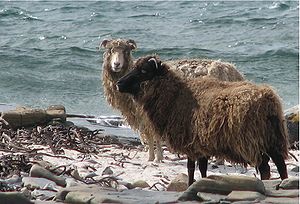
North Ronaldsay sheep
Encyclopedia

North Ronaldsay
North Ronaldsay is the northernmost of the Orkney Islands, Scotland and with an area of is the fourteenth largest.-Geography:North Ronaldsay lies around north of its nearest neighbour, Sanday at . The island is around long along its length and is defined by two large sandy bays; Linklet Bay on...
, the northernmost of the Orkney Islands
Orkney Islands
Orkney also known as the Orkney Islands , is an archipelago in northern Scotland, situated north of the coast of Caithness...
, Scotland
Scotland
Scotland is a country that is part of the United Kingdom. Occupying the northern third of the island of Great Britain, it shares a border with England to the south and is bounded by the North Sea to the east, the Atlantic Ocean to the north and west, and the North Channel and Irish Sea to the...
. They are one survivor of a type of sheep formerly found across the islands of Orkney and Shetland (the other is the Shetland
Shetland (sheep)
The Shetland sheep is a small, fine-woolled breed of sheep originating in the Shetland Isles, but now also kept in many other parts of the world. It is one of the Northern European short-tailed sheep group, and is closely related to the extinct Scottish Dunface. Shetlands are classed as a...
), belonging to the Northern European short-tailed sheep
Northern European short-tailed sheep
Northern European short-tailed sheep are a group of sheep breeds and landraces from the British Isles, Scandinavia, and the area around the Baltic. They are thought to be derived from the first sheep brought to Europe by early farmers...
group of breeds.
They are notable for living almost entirely on seaweed
Seaweed
Seaweed is a loose, colloquial term encompassing macroscopic, multicellular, benthic marine algae. The term includes some members of the red, brown and green algae...
for several months of the year, except for a short lambing season – this is the only forage
Forage
Forage is plant material eaten by grazing livestock.Historically the term forage has meant only plants eaten by the animals directly as pasture, crop residue, or immature cereal crops, but it is also used more loosely to include similar plants cut for fodder and carried to the animals, especially...
available to them, as they are confined to the shoreline by a 6 feet (1.8 m) tall dry-stone wall which encloses the whole island. The semi feral flock on North Ronaldsay is confined to the foreshore for most of the year to conserve the limited grazing inland. This breed is raised primarily for wool
Wool
Wool is the textile fiber obtained from sheep and certain other animals, including cashmere from goats, mohair from goats, qiviut from muskoxen, vicuña, alpaca, camel from animals in the camel family, and angora from rabbits....
.
Wool
WoolWool
Wool is the textile fiber obtained from sheep and certain other animals, including cashmere from goats, mohair from goats, qiviut from muskoxen, vicuña, alpaca, camel from animals in the camel family, and angora from rabbits....
from the sheep is spun in Lanarkshire
Lanarkshire
Lanarkshire or the County of Lanark ) is a Lieutenancy area, registration county and former local government county in the central Lowlands of Scotland...
on the Scottish mainland and returned to Orkney for sale. There is also a small wool processing operation on North Ronaldsay itself which produces fine clothing and other woollen goods for sale.
Other locations
In more recent years colonies of the sheep have been established inland and on other islands to prevent the entire breed being wiped out through catastrophe (such as foot and mouth). A small number have also been exported as an exotic breed.Characteristics
The sheep have evolvedNatural selection
Natural selection is the nonrandom process by which biologic traits become either more or less common in a population as a function of differential reproduction of their bearers. It is a key mechanism of evolution....
a somewhat different physiology
Physiology
Physiology is the science of the function of living systems. This includes how organisms, organ systems, organs, cells, and bio-molecules carry out the chemical or physical functions that exist in a living system. The highest honor awarded in physiology is the Nobel Prize in Physiology or...
from other sheep, due to their unusual diet – their digestive system has adapted to extract the sugars in seaweeds more efficiently, and they have an increased susceptibility to toxicity to the trace element
Trace element
In analytical chemistry, a trace element is an element in a sample that has an average concentration of less than 100 parts per million measured in atomic count, or less than 100 micrograms per gram....
copper
Copper
Copper is a chemical element with the symbol Cu and atomic number 29. It is a ductile metal with very high thermal and electrical conductivity. Pure copper is soft and malleable; an exposed surface has a reddish-orange tarnish...
. The grazing habits of the sheep have also adapted to their peculiar diet: instead of grazing during the day and ruminating at night as other sheep generally do, the North Ronaldsays graze as the tide
Tide
Tides are the rise and fall of sea levels caused by the combined effects of the gravitational forces exerted by the moon and the sun and the rotation of the Earth....
reveals the shore (twice in 24 hours), ruminating
Rumination
The term rumination , meaning "to chew the cud," is used in several contexts:-Digestive rumination:* In animals, rumination is a part of normal digestion, in which the animal brings up swallowed food , chews it, and swallows it...
at high water. The sheep's source of fresh water is limited to the few freshwater lakes and ponds along the seashore.

